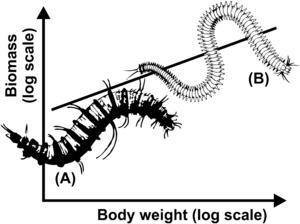A new study carried out at the National Oceanography Centre challenges a long accepted theory about how the biomass of animals living at the seafloor increases as animal size increases.
Results show that the complex trends detected by conventional sampling methods may be artefacts, and that the true relationship may be much simpler – and therefore easier to predict.
Animals living on the seafloor are grouped into different size classes according to their weight – meiofauna are smaller animals, dominated by nematode (thread) worms, and macrofauna are larger animals, dominated by polychaete (bristle) worms. For over three decades, biologists studying the biomass of animal populations on the seafloor have detected peaks in biomass in each of these size ranges.
But the findings of this study, published recently as a feature article in the journal Marine Ecology Progress Series, show that this pattern could simply be an artefact of the sampling methods used. Instead, it is likely that seafloor community biomass steadily increases through logarithmic body weight classes.
This simplified relationship should assist seafloor ecosystem modelling efforts, and give scientists a better understanding of the functional links between marine biology and environmental change.
NOC’s Dr Brian Bett, author of the paper and deep-sea biologist, explains “In the 1980s, some studies came up with results that showed that biomass increased in humps, with one of these humps corresponding to meiofauna and the next corresponding to macrofauna. Subsequently it was observed that the number of species recorded seemed to follow these humps as well. And that is the description to be found in standard text books today.”
But by means of a simple computer model, Dr Bett identified that these humps could indeed be detected but not as a result of real biomass and species diversity patterns, instead because of the methods used to sample seafloor life.
“The typical sampling procedure is to use two samplers – a big one for big animals and a small one for small animals – then to use a coarse sieve for the big sample and a fine sieve for the small sample. The computer simulation suggests that the characteristic humps are probably just the result of the two methods ‘missing’ the animals that fall between the two size groups.”
Dr Bett hopes that this simplification will stimulate more modelling efforts of seafloor ecology, such as carbon uptake and energy flow: “At the moment there are very few mathematical models of seafloor ecology. This finding makes the biogeochemical modelling of the marine environment a less daunting task.”
NOC researchers are using these findings to feed into new ecosystems models and maps of the deep seafloor.
“If you assume that these humps are a real feature of the biomass distribution on the seafloor, it makes it very complicated to model,” says Dr Bett. “Our model assumes a continuous distribution, with no peaks or troughs, making it much simpler to model the whole seafloor ecosystem and its biogeochemical interactions.”
Greater ecosystem modelling capacity will help with assessments to satisfy the UK’s commitments to international marine environmental regulation. The Marine Strategy Framework Directive, for example, requires information on marine ecosystem function and services and species diversity, all of which will be easier to assess if these findings are borne out and integrated into future research.
The work is an on-going part of a NOC multi-disciplinary research project, funded by the Natural Environment Research Council (NERC).
Image: From small nematodes (A, length 0.3mm) to large polychaetes (B, 300mm), seabed community biomass (grams per square metre) seems to increase continuously with individual body weight (grams) – with no gaps or troughs as normally shown in text books.

